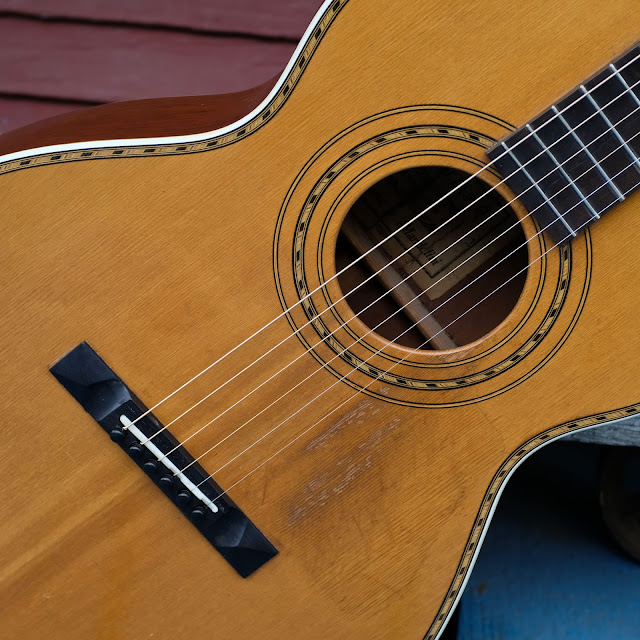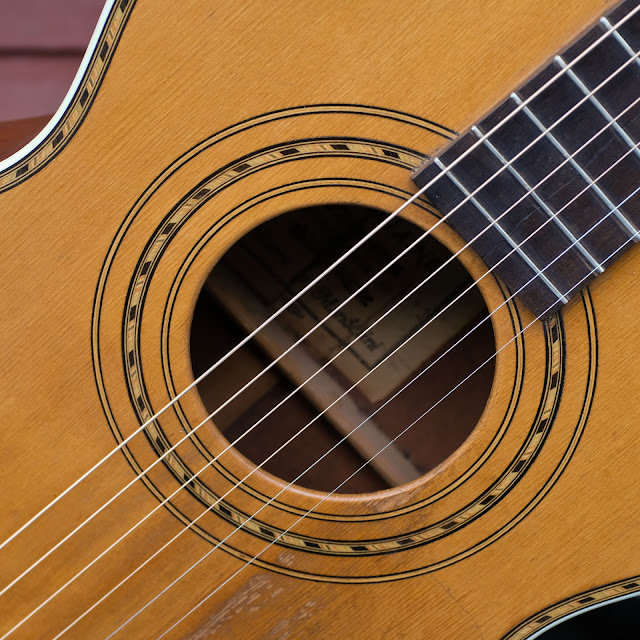1920s Cerrito-made Galiano 000-Size Flattop Guitar
This Oscar Schmidt-affiliated guitar was almost certainly made by "Italian Luthier Guild" maker Cerrito, as evidenced by a number of other similar guitars that I've worked-on in the last few years. Like the others, it's a high-quality guitar with a comfortable neck and handling and a long, peculiar, 26" scale length that begs to be strung just a hair heavier and tuned down C-to-C or C#-to-C# and fingerpicked like crazy.
While it's built in some ways a lot like the more mass-produced Oscar Schmidt Sovereigns of the same period, its overall design and construction is both lighter, more nuanced, and cleaner. As you'd expect, the tone is superior, too. It has a woody, balanced, and warm sound that flatpicks just as well as it fingerpicks -- which is not an easy task when asked of ladder bracing, which tends to favor a fingerpicking approach. It's thus less of a one-trick-pony and more rounded in sound along the lines of x-bracing (but not quite).
This guitar is in via a customer who may end-up selling it, but my work was pretty straightforward. It was clean when it came in, had a good neck angle, and has no cracks except for some dryness hairlines in the fretboard. Amazing, huh? Work thus included a fret level/dress, side dots install, scrounging of period replacement tuners, fill of the pinholes and saddle at the bridge and a recut of the saddle slot (for proper compensation) and relocation of the pins, a new bone saddle, new ebony pins all-around, and a good setup.
It's currently strung with 46w, 36w, 26w, 20w, 14, 10 strings for E-to-E stringing (though the 26" scale puts the tension-feel somewhere like 52w-11), though if this were my guitar I'd probably string it 54w-12 and detune to C or C# as mentioned earlier. The tension would be about the same but the mass of the strings at that pitch would probably give the top some good vroooom! The neck is straight and action is on-the-dot at 3/32" EA and 1/16" DGBE at the 12th fret.
Specs are: 26" scale, 1 3/4" nut width, 1 1/2" string spacing at the nut, 2 5/16" string spacing at the bridge, 15" lower bout, 10 1/2" upper bout, and 3 7/8" side depth at the endblock. The neck has a flat fretboard and a mild-to-medium, C-shaped rear profile. It's roughly comparable to playing an early-'60s Gibson but thickens-up around the 8th/9th frets.
Woods are: solid spruce top, solid mahogany back, sides, and neck, ebony bridge, and ebonized-maple fretboard. The headstock veneer is rosewood, the dots in the board are pearl, and the nut and bridge are bone. It's all-original save the saddle, pins, and tuners -- though the tuners are period stock.
While it's built in some ways a lot like the more mass-produced Oscar Schmidt Sovereigns of the same period, its overall design and construction is both lighter, more nuanced, and cleaner. As you'd expect, the tone is superior, too. It has a woody, balanced, and warm sound that flatpicks just as well as it fingerpicks -- which is not an easy task when asked of ladder bracing, which tends to favor a fingerpicking approach. It's thus less of a one-trick-pony and more rounded in sound along the lines of x-bracing (but not quite).
This guitar is in via a customer who may end-up selling it, but my work was pretty straightforward. It was clean when it came in, had a good neck angle, and has no cracks except for some dryness hairlines in the fretboard. Amazing, huh? Work thus included a fret level/dress, side dots install, scrounging of period replacement tuners, fill of the pinholes and saddle at the bridge and a recut of the saddle slot (for proper compensation) and relocation of the pins, a new bone saddle, new ebony pins all-around, and a good setup.
It's currently strung with 46w, 36w, 26w, 20w, 14, 10 strings for E-to-E stringing (though the 26" scale puts the tension-feel somewhere like 52w-11), though if this were my guitar I'd probably string it 54w-12 and detune to C or C# as mentioned earlier. The tension would be about the same but the mass of the strings at that pitch would probably give the top some good vroooom! The neck is straight and action is on-the-dot at 3/32" EA and 1/16" DGBE at the 12th fret.
Specs are: 26" scale, 1 3/4" nut width, 1 1/2" string spacing at the nut, 2 5/16" string spacing at the bridge, 15" lower bout, 10 1/2" upper bout, and 3 7/8" side depth at the endblock. The neck has a flat fretboard and a mild-to-medium, C-shaped rear profile. It's roughly comparable to playing an early-'60s Gibson but thickens-up around the 8th/9th frets.
Woods are: solid spruce top, solid mahogany back, sides, and neck, ebony bridge, and ebonized-maple fretboard. The headstock veneer is rosewood, the dots in the board are pearl, and the nut and bridge are bone. It's all-original save the saddle, pins, and tuners -- though the tuners are period stock.
Gorgeous, right? The mix of "marquetry" purfling, pyramid bridge, and big body size for the time make this a pretty striking period guitar.
My new saddle slot is drop-in for easy action adjustments and it's also fully-compensated.
Interestingly, the headstock has a section of mahogany grafted to it for thicknessing, too, on its rear.





















Comments